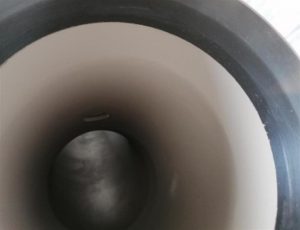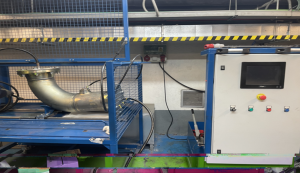![]() 24/11/2023
24/11/2023
How is the ACHIEF project validating the corrosion monitoring system?
Within the framework of the ACHIEF project, the consortium has focused on constructing a specialised pipe component integrating an innovative embedded sensor. This sensor was designed to evaluate corrosion-erosion degradation in PDC (polymer-derived coatings) solutions developed by CEA, specifically tailored for utilisation in the oil&gas industry. The PDC coatings were synthesised from a polysilsequixane commercial polymer, an inorganic filler (SiC) and a reach compatible solvent. The PDC coating was air sprayed onto the inner surface of the steel pipe and cross-linked at 200°C under air for 1h.

TÜPRAŞ [1] and AIMEN[2] have designed an experimental elbow pipe component following the standard three-electrode electrochemical cell configuration for measuring the corrosion rate by using Electrochemical Impedance Spectroscopy (EIS). As a result, the high sensitivity of EIS technique will allow it to identify changes in the coating long before any visible damage occurs.
AIMEN has been responsible for defining, designing, and manufacturing the corrosion monitoring system tailored to fit the dimensions (both size and geometry) as well as the operating conditions (including temperature and pressure) of the specific TÜPRAŞ refinery. This meticulous customization was based on the detailed information furnished by TÜPRAŞ , ensuring optimal functionality and compatibility with the refinery’s requirements.
The purpose behind these actions were to expose the coated pipe section with embedded electrodes for online and onsite monitoring of the barrier properties of the PDC coating and the identification of degradation mechanisms (corrosion-erosion) against an aggressive petrochemical fluid. The demonstration of the two new technologies developed within the ACHIEF project will be conducted in a real industrial setting at TÜPRAŞ İzmit refinery. In this context, AIMEN will periodically perform and analyse EIS measurements to determine the corrosion behavior of the PDC coating on real time and under real operating conditions.
In this context, in October 2023 TÜPRAŞ experts in non-destructive tests, visited the facilities of AIMEN to supervise the validation tests of the demonstrator before the installation in the plant. Prior to the installation of the demonstrator in TÜPRAŞ facilities, tightness tests have been implemented with the aim to guarantee the proper performance and safety of the corrosion monitoring system integration. This testing stage allows to identify leakages in different parts of the probe, especially in the welding areas and the connections with the external circuit.
Furthermore, AIMEN has specifically designed and constructed a test bench (Figure 1) for this high-pressure hydrotest. According to the test conditions, they need to meet the operational parameters (P and T) to be achieved at TÜPRAŞ site (P (testing)= 5.3 kg/cm2). The test bench incorporates a high-pressure water pump, utilised for filling the circuit with distilled water at the necessary pressure, ensuring that the coating remains undamaged. Additionally, the team also performed a liquid penetrating test to analyse the welding quality and make the corrections required.

Besides, preliminary EIS measurements were carried out during the high-pressure tests to ensure the performance of all the electrical connections and the reliability of data that will be provided during the electrochemical based-corrosion monitoring at TÜPRAŞ site.

This data will be crucial for the TÜPRAŞ site electrochemical-based corrosion monitoring. As a next step, the team will install the entire combined system including PDC coating, embedded sensors and monitoring equipment at TÜPRAŞ refinery by the end of 2023. This developed technology will be monitored in real refinery conditions for – at least – six months until the end of the project.
[1] TÜPRAS team: Cem Aciksari, Orhun Oguz, Safhak Turan and Murat Can Erdemir
[2] AIMEN’ team: Julio Sánchez, Rubén Castro, Aitor Bouzas, Ignacio Ezpeleta and Lorena Freire




